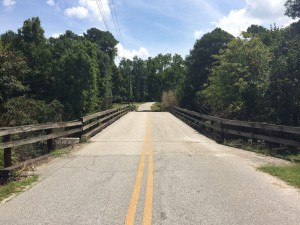
The Cornelia City Commission has responded to a vocal and active public outcry against the proposed removal of the Hoyt Street bridge. Commissioners, at Tuesday’s regular meeting, instructed city manager Donald Anderson, to communicate with Norfolk Southern Corporation and let them know that the city would not approve the railroad company’s request to remove the bridge.
In a July 21 letter from Norfolk Southern to the city, the company indicated that, “due to the bridge’s vertical and horizontal clearance envelope,” the bridge “currently hinders our efforts” to maintain the track beneath the bridge. Norfolk Southern requested the city’s approval to remove the bridge at Norfolk Southern’s expense.
“We have also noted that there are numerous ways to traverse Norfolk Southern’s tracks in the area, including the Wayside Street Overpass to the south or the Wells Street underpass to the north,” states Norfolk Southern.
A public hearing was hosted by the city commission regarding the removal of the bridge, at which three people spoke in favor of removal; no one spoke against the removal.
“Their (Norfolk Southern’s) reason for the request is because, if you look at the bridge, they say it was built for horse and buggy, that’s how old it is,” Anderson says, describing the old wooden trestle bridge. “They claim the height of the bridge was restricting their ability to properly maintain the tracks,” he adds, pointing out that the city conducted measurements of the bridge and discovered that the Hoyt Street bridge is three inches taller than the Wayside Bridge, which is a fairly new bridge.
Following the public hearing, city officials placed barricades at the Hoyt Street bridge.
“Before the commissioners made a decision, we tried a little experiment where we barricaded the bridge to simulate the closure,” Anderson says. “When we did that, the calls just came flooding in; a lot of people over there did not realize what an inconvenience it was going to be to have to go all the way around town to get to Walmart or whatever.”
Public response to the simulated closure of the bridge was both overwhelming and insistent, says Anderson.
“The plan was to have the barricades up for two weeks and we didn’t quite make it; after about a week, the public finally got tired of it and actually took the barricades down and threw some of them down on the train tracks,” he says. “Plus, we were bombarded with phone calls at city hall from people in the area telling us what an inconvenience it would create, and the postmaster called to tell us they would have to drastically change their delivery route.”
Safety could, at some point, be a considerations regarding the bridge, due to its age and construction. However, regular inspections by Georgia Department of Transportation (GDOT) engineers have not revealed any safety issues to date.
“The way it works is, GDOT sends an inspection engineer every few years to inspect bridges and determine weight limits (Hoyt Street Bridge is currently rated at 7 tons). Nothing has been pointed out to us structurally,” Anderson says. “There is a law specifically for bridges in Georgia and, as far as the structure, that is 100 percent the railroad’s (responsibility), so if that was determined to be structurally unsafe, it would be at their expense to fix it. The city’s responsibility is for maintaining the surface — paving it — and for the guard rails.”
Commissioners agreed that it was not in the best interest of the city or the residents to allow the bridge to be removed.
“Based on the input we’ve received in the last month, the decision was to tell the railroad ‘no, we’re not going to give you permission to take the bridge down,’” Anderson says. “Based on the law, the railroad cannot take the bridge down without the city’s permission — essentially, it is the city’s call.”







